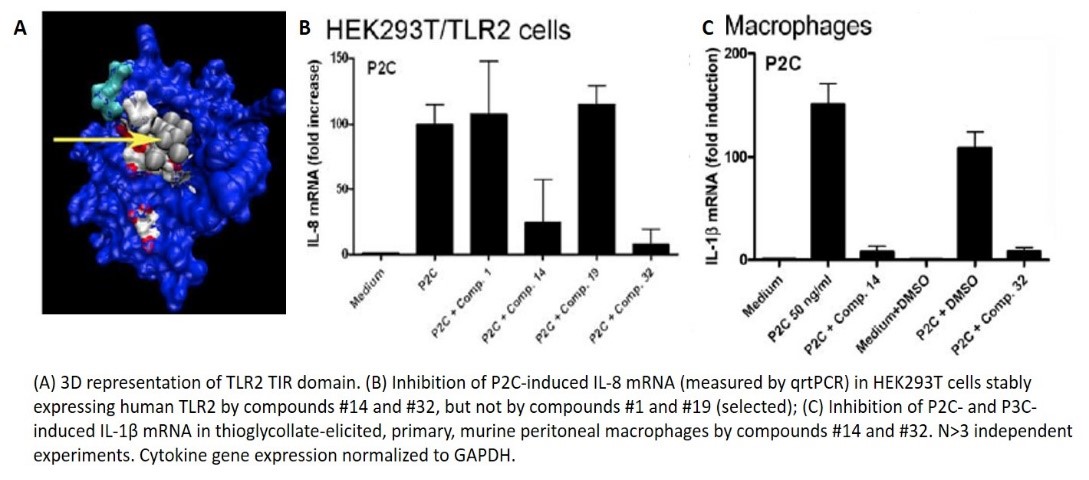Overview
Toll-like receptors (TLR) are innate immune molecules involved in the detection of microbial and self-ligands released from damaged cells. At their C-termini, toll/interleukin-1 receptor (TIR) domains dimerize upon ligand binding, initiating a signaling cascade that results in the upregulation of inflammatory cytokines. Excessive signaling can lead to a cytokine storm, a potentially fatal immune reaction. Dysregulated TLR2 signaling has been explicitly linked to conditions involving the production of proinflammatory cytokines, such as sepsis, atherosclerosis, tumor metastasis, and ischemia/reperfusion injury. Based on the published crystal structure of the TIR domain of TLR2, UMB researchers used computer-aided drug design (CADD) to identify small molecule inhibitors that may disrupt TLR2 signaling. This in silico screening identified 169 small molecule TLR2 inhibitors that potentially disrupt TIR-TIR interactions. Some of these compounds demonstrated in vitro and in vivo selective TLR2 inhibition and the ability to inhibit TLR2-induced inflammation.
Using CADD, approximately 150 molecules and 20 FDA-approved drugs were identified as candidate inhibitors. Drug candidates were screened for their ability to block TLR2 ligand-mediated signaling leading in a humanized cell line, with some compounds further screened for specificity in murine and human macrophages using non-TLR2 ligands. Several potential TLR2-specific antagonists have been identified, as well as compounds with broader inhibitory capacity. Based on the structure of these active compounds, additional structurally related compounds can be identified.

Applications
As modulators of innate immunity, the scientific literature supports the use of TLR2 inhibitors as potential therapeutics for the prevention and treatment of autoimmune and inflammatory diseases. Despite the promise of TLR2 antagonists, few compounds targeting this complex have been developed. Currently, there is only one TLR2 signaling inhibitor in clinical development. This TLR2 inhibitor is a humanized monoclonal antibody for patients with myelodysplastic syndrome and for the prevention of delayed graft function following renal transplantation.
Advantages
Small molecule inhibitors of TIR-specific TLR signaling
Potential to identify additional structurally-related compounds
Therapeutic potential in conditions involving TLR2 signaling such as sepsis and inflammation
Stage of Development
Drug candidates were screened for TLR2 inhibitory activity in a human cell line (HEK293T) that expresses TLR2. Ideal candidates were identified by their ability to block TLR2 ligand-mediated signaling leading to IL-8 mRNA expression. These lead candidates were further tested for TLR2 specificity in murine and human macrophages. The ability of some compounds to inhibit TLR2/1-induced proinflammatory cytokines was also tested in vivo in mice.
Licensing Potential
Available for licensing
Contact Info
Office of Technology Transfer
620 W Lexington St., 4th Floor
Baltimore, MD 21201
Email: [email protected]
Phone: (410) 706-2380